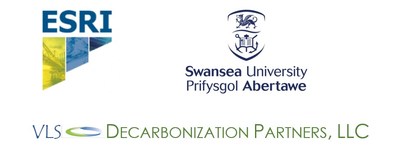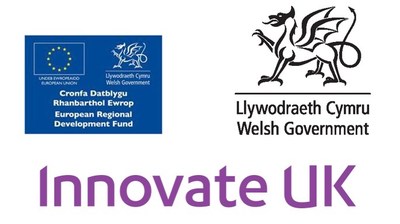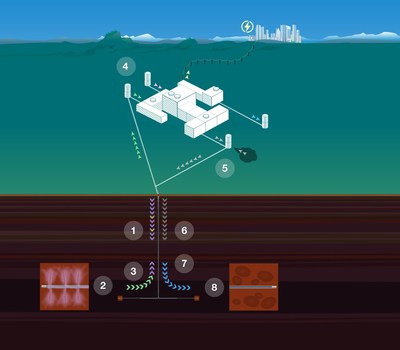Subject: ENI
UK Environmental Coalition Pursues Very Large Scale Decarbonization Technology in Support of Government's Recently Announced Clean Growth Initiative
LONDON, June 7, 2018 /PRNewswire/ -- On Wednesday 23 May, UK Energy and Clean Growth Minister Claire Perry announced the UK's goal to lead an international challenge with Saudi Arabia and Mexico to remove carbon from emissions.

Consistent with this objective and highlighting the important role of innovation in supporting cost reduction, Very Large Scale Decarbonization Partners (VLS Decarb) announced its intention to carry out field trials of its profoundly large scale capable CO2 sequestration system in several UK and EU locations.
The company's major-market patented and globally patent pending suite of technologies hold the potential to sequester atmospheric CO2 at the levels stipulated by the Paris Climate Change Accord of December 2015. Specifically, it could remove volumes of CO2 sufficient to arrest the progression of climate change and potentially reverse harmful effects being experienced from unmitigated CO2 emissions of human origins.
The VLS Decarb Research and Development Consortium ? During the past five years, the technology has been advanced by an extensive R&D collaboration involving VLS Decarb's academic and industry partners, the Energy Safety Research Institute (ESRI) at Swansea University and an international array of academic and governmental institutions and funding agencies. This research and development partnership, funded by Innovate UK, has led to the development of novel materials that are key to enabling the Carbon Capture and Storage (CCS) concept.
In addition to an industry partnership with Glass Technology Services (GTS), ESRI brings a significant ongoing collaboration agreement with King Saud University, which aligns with the UK Government's international challenge with Saudi Arabia. The enabling research for this project has been supported by Innovate UK, the Welsh Government Sêr Cymru Chair Programme, and the FLEXIS project, which is part-funded by the European Regional Development Fund (ERDF) through the Welsh Government.

Field Trials ? In the field thus far, specifically focused and scoped tests have been undertaken which have demonstrated the viability of various key components of the system. The complete process will be tested in field trials going forward and the results are expected to demonstrate the widespread applicability of the technology and its commercial viability and self-sustaining features, such as supporting intermittent supplies of electric power generation (wind, wave and sun) while also providing the electric power required to drive the sequestration process itself.
The CO2 storage and power generation potentials are:
- Approximately 35 years of global electric power requirements net of the energy consumed in sequestering all global CO2 emissions from all sources during the same time interval is provided by VLS Decarb alone.
- If wind, wave and solar, along with similar cohorts of clean (carbon neutral) energy sources could provide 50% of needs during the time we are sequestering, the result would obviously be approximately 70 years of carbon free electricity worldwide, with zero net CO2 emissions from all sources.
|
Table of VLS Decarbonization Global Potentials - CO2 Sequestration & Surplus Power Supply | ||
|
Units |
CO2 Sequestration - MMT |
Power Generation - TWh |
|
3X Average Adsorption Ratio |
Developed World Average Heat Rate | |
|
Global Statistics in 2015 |
35,700 |
24,000 |
|
Global Technically Recoverable - 7,570 TCF |
1,259,500 |
1,018,250 |
|
Years of Global Coverage @ 100% |
35.3 |
42.4 |
|
Surplus After Sequestration @ 3X |
33.9 | |
|
Years of Global Coverage @ 50% |
70.6 |
84.9 |
|
Assumes Wind, Wave, Sun, Other = 50% |
||
|
Surplus Power After Sequestration |
67.9 | |
Here is how it works... Research data demonstrates that the best use of unconventional (shale) reservoirs is to store CO2, the noxious byproduct of burning natural gas and other fossil fuels. Shale formations, which are ubiquitous in the Earth's crust, can potentially be harnessed to permanently store injected CO2 for time intervals measured in geologic terms, literally hundreds of millions of years. The following image illustrates the process, which occurs in eight basic steps:

? Temporarily accessing planetary shale source rocks with a completely non-toxic production system and removing the natural gas (methane) within them.
Steps 4 & 5 ? Massive surplus electric power production (net of the carbon capture and sequestration operations) while simultaneously achieving an extraordinary negative carbon footprint and the production of large volumes of fresh water.
Step 6, 7 & 8 ? Refilling the emptied reservoir spaces with many times more volumes of atmospheric carbon dioxide than generated from the extracted methane, and then terminating the access pathways from these containers via natural bio-degradable means resulting in permanent large-scale CO2 sequestration throughout geologic time which is not dependent upon vertical well bore durability.
ESRI Founder and Director Prof Andrew R Barron said, "Through funding of various components by the UK and the EU via the Welsh Government, this work has focused on one of the biggest challenges facing humanity in the next decades and has been a true multi-vector collaboration. The beauty of this effort is that it is based on an entirely new approach that takes into account the scope of the CCS challenge as well as the economic reality that must accompany CCS. These efforts fit in with the Glass Futures Initiative that is aimed at creating future technologies and applications for the glass industry."
VLS Decarb Founder John Francis Thrash MD said, "Carbon sequestration in source rock deposits is a universally available solution for permanently removing carbon from the environment that has been sitting plainly before our eyes and yet un-noticed until now. Ironically, the methane extraction allows for disposal of the necessary volume of CO2 required to reverse climate change. All of this is accomplished in one sustainable, commercially viable operation."
About VLS Decarb, and the Energy Safety Research Institute
Very Large Scale Decarbonization Partners (VLS Decarb) has been formed to utilize the company's proprietary suite of major market patented and globally patent pending technologies to further develop, and deploy at scale, clean commercial energy strategies which will result in profoundly reduced planetary atmospheric CO2 through emissions elimination and permanent sequestration.
John Francis Thrash MD is Chairman and CEO of VLS Decarb and a key contributor to the creation and development of VLS Decarb's proprietary intellectual property.
The Energy Safety Research Institute is positioned to discover and implement new technology for a sustainable, affordable, and secure energy future and is housed on Swansea University's new world class Bay Campus. ESRI provides an exceptional environment for delivering cutting edge research across energy and energy safety-related disciplines with a focus on renewable energy, hydrogen, carbon capture and utilization, as well as new oil and gas technologies.
Prof. Andrew R Barron is the Sêr Cymru Chair of Low Carbon Energy and Environment at Swansea and the Founder and Director of ESRI, as well as the Charles W. Duncan Jr.?Welch Chair of Chemistry and a Professor of Materials Science and Nanoengineering at Rice University in Houston, Texas. He is the recipient of a £9.2 million ($12.25 million) project "Reducing Industrial Carbon Emissions" that includes new technology demonstration of CO2 separation from industrial sources in South Wales.
Glass Technology Services is a globally recognised independent expert in glass research and development, testing and consultancy. Its team works with partners and customers at every stage of the development cycle and supply chain to drive innovation, growth and sustainability in glass. Their R&D projects range from development of new glass materials and manufacturing processes to product commercialisation. Recent work has spanned the medical, defence, energy, oil and gas, laser, optics/photonics and waste processing sectors.
Contacts
Prof. Andrew R Barron: e-mail: [email protected]
John Francis Thrash MD: email: [email protected]
Related materials
ESRI: http://www.esri-swansea.org
Swansea University: http://www.swansea.ac.uk/
Follow ESRI via Twitter @ESRI_Swansea
Disclaimer
The press release may contain certain statements that constitute forward-looking statements under applicable securities legislation. All statements other than statements of historical fact are forward-looking statements. In some cases, forward-looking statements can be identified by terminology such as "may", "will", "should", "expect", "plan", "anticipate", "believe", "estimate", "predict", "potential", "continue", or the negative of these terms or other comparable terminology. These statements are only as of the date of this document and we do not undertake to publicly update these forward looking statements except in accordance with applicable securities laws. Forward-looking statements are based on current expectations, estimates, projections and assumptions, which we believe are reasonable but which may prove to be incorrect and therefore such forward-looking statements should not be unduly relied upon. In addition to other factors and assumptions which may be identified in this document, assumptions have been made regarding, among other things: industry activity; the general stability of the economic and political environment; effect of market conditions on demand for the Company's products and services; the ability to obtain qualified staff, equipment and services in a timely and cost efficient manner; the ability to operate its business in a safe, efficient and effective manner; the performance and characteristics of various business segments; the effect of current plans; the timing and costs of capital expenditures; currency, exchange and interest rates; the regulatory framework regarding environmental matters in the jurisdictions in which the Company operates; and the ability of the Company to successfully market its products and services. Forward-looking statements are subject to a number of risks and uncertainties, which could cause actual results to differ materially from those anticipated. These risks and uncertainties include: general global economic, political and business conditions; weather conditions; regulatory changes; the successful exploitation and integration of technology; customer and public acceptance of technology; success in obtaining issued patents; the potential development of competing technologies by market competitors; and availability of products, qualified personnel, manufacturing capacity and raw materials. In addition, actual results could differ materially from those anticipated in these any forward-looking statements.
Logo - https://mma.prnewswire.com/media/702368/VLS_Decarbonization_Partners_Logo.jpg
Photo - https://mma.prnewswire.com/media/702367/VLS_Decarbonization_Partners.jpg
These press releases may also interest you
|
News published on and distributed by:



